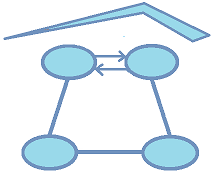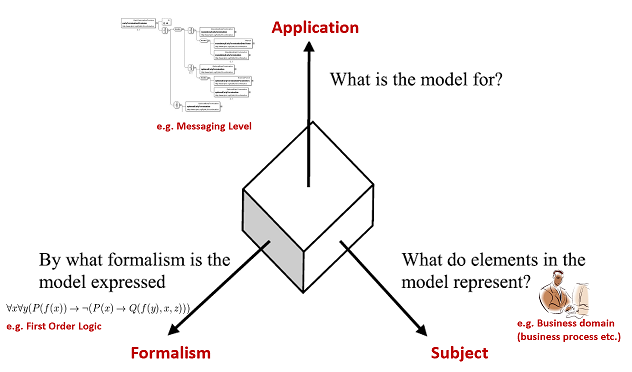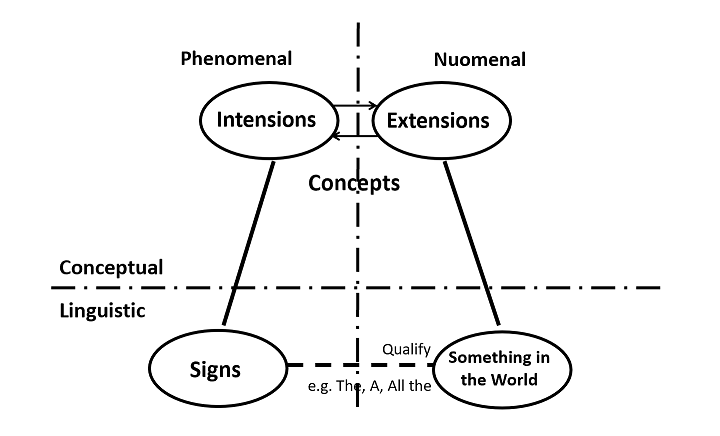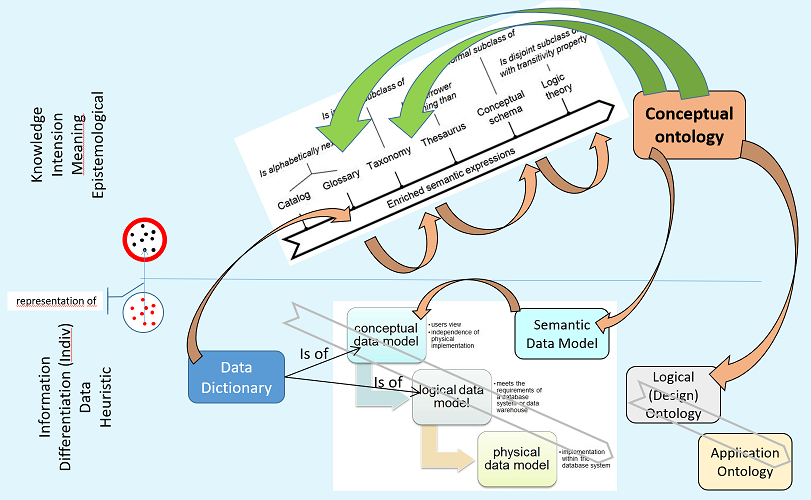
|

|

|

|

|

|

|

|

|

|

|

|

|

|

|
The Semantic Shed is a community of practice formed to bring together the best thinking in industry and academia for the development and deployment of ontologies. Our unique framework (the 'Semiotic Rhombus') defines the nature and use of concept models alongside other kinds of formal model, indicating where in this mix you can get the most out of different kinds of what we call 'ontology'.
The Semantic Shed Framework is further extended into formal methodology by which to derive a range of conventional data models and ontology solutions from a common reference ontology of the things in the world.
The Semantic Shed is also developing a formal concept ontology, called the Shed Business Concept Ontology (SBCO). This is a concept ontology (an ontology of the real things in the world, not the data about the things); it has a Top Level Ontology, a set of mid-level or cross-domain terms (a Concept Library) of common 'archetypes' (simplest kinds of thing) such as Contract, Commitment; and extensions into common areas of business, commerce, finance and insurance.
It started in a shed in rural Wales, when a group of fellow travelers in the areas of ontology, vocabulary management, financial data, standards and technology got together to address the question: "What would a truly concept-focused ontology for business and finance look like?". This question was not as simple as it might first seem, since there had been efforts that many of us were involved with to provide industry standard ontology models in this space; it was the lack of a clear answer to this problem that led us to ask it. The result was a set of clear commitments and guidelines as to what makes up a concept-focused or 'reference' ontology suitable as a common language for integration and model driven development, and more contentiosly, how this could be clearly distinguished from some of the other things are called ontologies. We found ourselves in the role of a sort of standards underground; a geurilla research institute, working on problems that were either overlooked or ignored in some corners of the ontology development space. We found ourselves trying to bring together the often separate worlds of the 'Applied Ontology' academic discipline and the 'Semantic Web' ontology development community. Each of these groups often means something subtly different by the word 'ontology' even though sometimes the same models are presented as being usable in both contexts. What were the rules for such re-use, and if we weren't going to write them, who would?
Overall our aim is to create activities, events and formal deliverables that have value for each of our member constituencies - consultants (and vendors), academics, industry end users and people who may at any given tine belong in two or more of these categories, or whose careers may take them from one of these to another.
Many members of the Semantic Shed are independent consultants or run specialist consultancy firms. Where opportunities exist that make use of our Methodology and Framework, members are encouraged to build out proposals that can call on other members of the Shed community to be part of their business offering.
A separate business vehicle exists and will be developed further to take these consultancy offerings forward.
Our ethos at the Semantic Shed is to draw upon the best of available knowledge. To this end we study, attend and learn from the best in Applied Ontology. In turn, we try to submit and publish or present as much of our work as possible at suitable academic and industry events and publications, generally under our own affiliations. In this way we get as much peer review as we can for the thinking and framings we develop in this community.
If you work at an end user firm such as a bank or other institution, we hope that the work we are producing at the Semantic Shed gives you something you can use in your day job. We also don't lose sight of the fact that at some future time you may find yourself as a freelance consultanct or may embark on a course of study in one of these areas.
Data is the vital fluid of any organization – but just how fluid is your data? Does your data contribute to business knowledge? Most firms are familiar with the problem of data being located in different silos and framed in different formats - requiring costly technology initiatives whenever data needs to be used in more than one place, for example for regulatory compliance, risk management and reporting. The real costs however may go deeper, costs measured as failures in corporate governance or in lost business opportunities or unseen risks. Are these hidden costs affecting your bottom line or business flow? Can your business afford these risk exposures?
In the financial crisis of 2008 many large financial institutions were exposed through an intricate network of financial interconnections to firms that failed. There was no shortage of data and yet some firms took weeks to translate that data into actionable knowledge. They did not lack data, but the data lacked business meaning when it was needed. Without meaning the data was not actionable as knowledge.
Ten years on, many of the same challenges remain, both in financial institutions and elsewhere.
The key is this: the ultimate management of IT assets does not happen in IT. The business as a whole needs a clear handle on the concepts that are reflected in the organization's data, and the business disciplines to ensure that IT delivers against business needs. There is a range of tools and techniques for this, collectively known as data management maturity. Ontologies represent one of those techniques: common reference models of the meanings of things.
A reference model for meaning (or more accurately, for concepts) is known as an 'ontology'. Think of it like a kind of dictionary but written in pure logic rather than words. The development and maintenance of this kind of ontology starts with the business, and provides stakeholder oversight of data assets, for example in model driven development, integration, maintenance, reporting and other uses of these IT data assets or in development of novel IT applications such as smart contracts in the Blockchain space, or artificial intelligence applications.
There are other resources also called 'ontologies' that provide more targeted capabilities, and these sometimes use similar formalisms, languages and techniques. These provide valuable new IT application opportunities such as inference processing, enabling the user to gain new insights from existing data. Being another kind of application, these ontology applications are subject to the same disciplines as other IT assets. We are able to help you put in place the development and management processes for these kinds of resource based on our unique semantics-based methodology and its separation of concerns.
Any formal model can be thought of in terms of at least three independent variables:

The key to managing models within the enterprise is to resognize, document and manage these dimensions of each model artifact. It is often supposed that a given formalism, e.g. OWL or UML, brings with it a specific model commitment. This is not the case. A logical model in OWL is still a logical model, while a model in UML is not necessarily not an ontology, even though it may not be a very good one. Languages vary in their appropriateness for one or another task, but simply using a given language does not guarantee that the model is the right kind of model for a given purpose.
Out of this common set of model dimensions and variables we isolate a particular kind of model: the business concept ontology. This is a kind of business concept model in which the formalism is formal logic (starting with first order logic), the model commitment is to real things in the world, and the model purpose is that of a computationally independent model. From this kind of model it is possible to derive Semantic Web 'operational' ontologies for reasoning applications, as well as conventional data models, integration and model driven development, in the technology sphere. Outside of technology this same kind of model also has uses in communicating business knowledge and understanding how a given enterprise frames its perceptions of the world. This has immediate business value in reporting, management decision making, investment analysis, mergers and acquisitions.
This is our unique representation of the semiotics of a computationally independent concept ontology.

The methodology is about deriving the right kinds of data models and application ontologies from a common concept-focused ontological model of the business. Parts of this are under development within the Semantic Shed - this is one of our main activities.

Material developed to date includes a set of transformation approaches for extracting context-specific ontologies for different kinds of context, for example the perspectives of different parties in a business activity, or the perspective of different points in time in a business workflow. The Methodology sets out some simple design rules for operational ontologies and looks at how to derive these kinds of ontology from a common reference ontology model that spans multiple business contexts. We have published and presented on this work at a couple of venues and will continue to do so through 2019 as this methodology progresses.
Our regular events include:
Stay tuned for more details on these.
These take place every Thursday, by invitation. Calls follow a monthly 'cycle' similar to a sprint, in which we take a basic problem area (either a methodology feature or some new ontology content, or both), develop the theory, do further research, pin this down into something practical and deliverable, and then show the resulting delivery to the group on the final Thursday of that month. We sometimes invite other speakers or thinkers to contribute to these ideas.
These occasional events generally take place whenever there is an event or conference that a few of us are attending and some development to be done on the Methodology, the Framework or the reference ontology.
Notable Mini-Sheds in the past have included Toronto (Top Level Ontologies), Amsterdam (Methodology Proof of Concept), Bolzano (Framework development) and Stockholm (Semantics of REA, Claims and Value).
The 4th Annual Semantic Shed Summer Camp will take place in Montreal, QC, Canada, July 8th through 12th. Attendance is by invitation.
Powered by

Follow @MikeHypercube